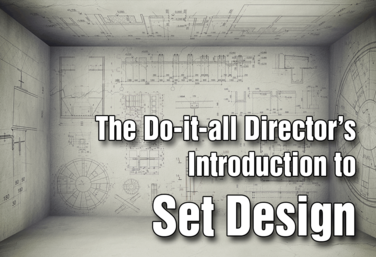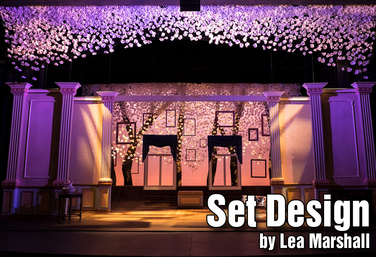Courses

PD COURSE
Concept-Based Design for the Theatre Teacher
by Matt Webster
Concept-Based Design is a method of design that allows the director and production team to create a unified world based on the ideas, perceptions and images extracted from an in-depth analysis of the play. Matt Webster designed this course for theatre teachers in a typical school setting with limited budgets, space and materials to use towards the design of their shows. Many theatre teachers feel most unsure about their design and tech skills and Matt wanted to help those teachers look at design differently, and make designing a show a little less scary and a little more fun!
Read More
about Concept-Based Design for the Theatre Teacher
Read Less
about Concept-Based Design for the Theatre Teacher

PD COURSE
The Do-it-All Director's Introduction to Set Design
by Holly Beardsley
Holly Beardsley is a do-it-all director. She started directing middle and high school students in her early college years and since then has written over ten shows and directed twice as many.
Do-it-all directors are responsible for everything it seems – the direction, the costuming, the choreography and of course, the set too. And though directors are ready to direct, to costume and even dance, there is something intimidating about designing and building a set.
The Do-it-All Director’s Introduction to Set Design will give you the director, who must do-it-all, the confidence and skills to not only direct but build your own set as well - no matter your experience or budget. This course will teach you set design basics, construction tips, budget tricks, and how to tackle your precious performance space armed with a hammer, and most importantly, without fear.
Read More
about The Do-it-All Director's Introduction to Set Design
Read Less
about The Do-it-All Director's Introduction to Set Design
Units

UNIT
Introduction to Set Design *Hyperdoc
by Lea Marshall
The purpose of this unit is to give students an introduction to independent learning as well as an overview of Set Design. Students will apply their knowledge throughout, and the unit culminates in a group activity.
This unit is delivered in hyperdoc format. What does that mean? A hyperdoc is an interactive tool that encourages digital learning. In this case, students are given a document on a subject, and there they can read articles, watch videos, do some independent research, and apply what they’ve learned. Because they’re working on their own, students are in charge of their own pacing.
Before you start the unit, ensure you read the Teacher Guide first. It will give you clear instructions on how to distribute the hyperdoc format and make it easy for you and your students.
Read More
about Introduction to Set Design *Hyperdoc
Read Less
about Introduction to Set Design *Hyperdoc
Lesson Plans
LESSON PLAN
Properties & Prop Design
by Karen Loftus
In this lesson, students will take what they learn about the different types of props and how props are created or acquired in order to apply it to a specific project. Using their critical thinking skills, they’ll have to invent, design, and create a science fiction style prop for a hypothetical show.
Read More
about Properties & Prop Design
Read Less
about Properties & Prop Design
LESSON PLAN
Design - Line and Shape
by Karen Loftus
Design, it’s not just for Art class anymore! A way to help your drama students understand abstract concepts is to let them take them for a test drive.
In this very basic exercise, students explore the design elements of line and shape using only a pencil and a sheet of paper.
Read More
about Design - Line and Shape
Read Less
about Design - Line and Shape
LESSON PLAN
Emergency Lesson Plan: Set Design Masterclass
by Lindsay Price
In this ELP, students participate in an online masterclass on directing and complete a viewing quiz.
Read More
about Emergency Lesson Plan: Set Design Masterclass
Read Less
about Emergency Lesson Plan: Set Design Masterclass
Resources

RESOURCE
Masterclass with George Ledo: Scenic Design
Masterclass is a series of one-on-one interviews with experts, creators and innovators in the world of Theatre that you can study in-depth, or share with your classes. Think of this series as ‘Inside the Actor’s Studio’ for Drama Teachers.
This Masterclass with George Ledo is all about Scenic Design, and is hosted by Matt Webster.
Read More
about Masterclass with George Ledo: Scenic Design
Read Less
about Masterclass with George Ledo: Scenic Design
Attachments
RESOURCE
Tech Hacks and Exercises
How do you teach tech, or use tech in your productions when you don’t have the expertise or the equipment? How do you make it work? How do you problem solve? Topics include Lighting, Set Design, Costumes, and Sound.
Read More
about Tech Hacks and Exercises
Read Less
about Tech Hacks and Exercises
RESOURCE
0 - Overview
In this project, students will be introduced to the steps of a concept-based design process and apply it to simple stories. This process gives students a new framework to approach creative challenges in the design process. Students will present design portfolios utilizing the elements of MELT. (Mood, Era, Location, Theme) with the use of the “What If” game. These elements are the building blocks of both the exploration and execution of their designs. By employing MELT and What If, students will generate the details and circumstances of the concept-based designs they will present.
Read More
about 0 - Overview
Read Less
about 0 - Overview
Attachments
RESOURCE
01 - Part 1: MELT (Mood, Era, Location, Theme)
By applying the elements of MELT, students will re-envision a classic story, myth, or fairy tale. Students will then share the newly envisioned story with their peers.
Read More
about 01 - Part 1: MELT (Mood, Era, Location, Theme)
Read Less
about 01 - Part 1: MELT (Mood, Era, Location, Theme)
Attachments
RESOURCE
02 - Part 2: Must Haves
By identifying required elements (as dictated by the content of their assigned stories), students will compile a list of materials that are the essential components of their designs. From there, they can alter and expand their designs based on the conceptual interpretation of their stories.
Read More
about 02 - Part 2: Must Haves
Read Less
about 02 - Part 2: Must Haves
RESOURCE
03 - Part 3: The "What If" Game
Students will generate a simple conceptual statement for their stories. Working from their list of “must haves,” students will brainstorm various ways of achieving the requirements of their stories based on this concept statement, using newly imagined objects, items, or materials aligned to their stated concept. By asking “What if,” students will begin to reimagine the design of the world of their stories in unexpected ways. This will provide them with a much more complex approach to their designs.
Read More
about 03 - Part 3: The "What If" Game
Read Less
about 03 - Part 3: The "What If" Game
RESOURCE
04 - Part 4: Group MELT Exercise
Students will reconstruct the world of their stories based on the information they visualized in the “What If” game. Using that information, students will complete the Group MELT Exercise worksheet, research images/materials that best represent the new story world they have designed, and create a design presentation for their new story concept.
Read More
about 04 - Part 4: Group MELT Exercise
Read Less
about 04 - Part 4: Group MELT Exercise
RESOURCE
05 - Part 5: Project Presentation
Students will present their completed design collages, including scenic, costume, and lighting designs for their assigned stories; give a presentation of the reimagined design elements of their stories based on the concept and imagery created throughout this project; and give an oral presentation that describes their concepts and the process they used to create their concepts. Students will take questions from both their teacher and their peers in order to clarify their concepts.
Read More
about 05 - Part 5: Project Presentation
Read Less
about 05 - Part 5: Project Presentation